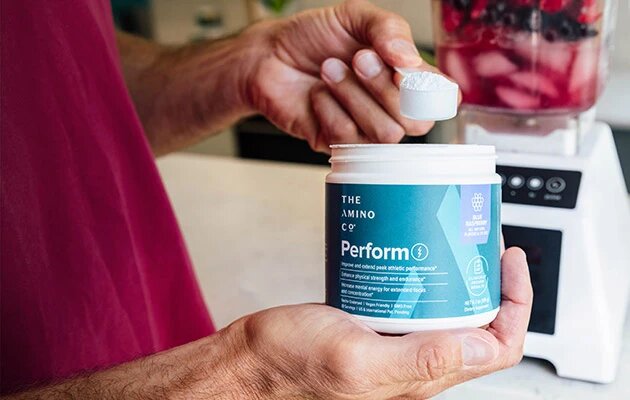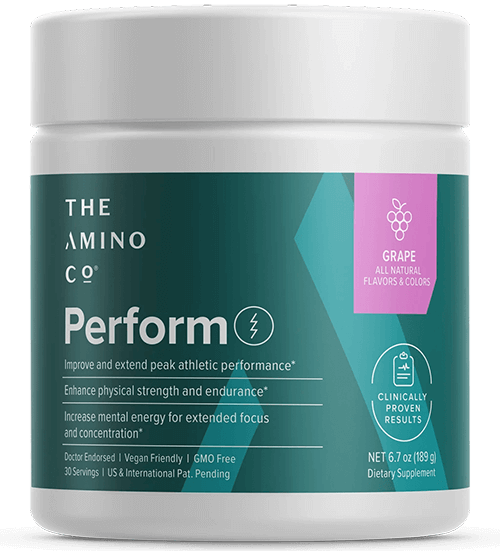How to Build Leg Muscle with Bad Knees: Top 7 Exercises
 By: by Amino Science
By: by Amino Science

The muscles in your lower body should be some of the strongest ones you have since they're tasked with supporting your entire frame every day. However, if you have one or two damaged knee joints, or general knee pain that you don't want to exacerbate, how are you supposed to perform leg exercises to gain better strength? Never fear: it can be done, and we have the details on how to build leg muscle with bad knees right here.
The Mechanisms of the Knee
The knee is the space where our femur (thighbone) and tibia (shinbone) meet behind the kneecap, with protective cartilage in between. It's known as a hinge joint—like our elbows, it is designed to bend one way and not the other.
The knee is also made up of ligaments and tendons that secure the bones in place, and muscles that run the whole operation. A "bad knee" could mean anything from degenerative joint disease, pain from a previous injury to the ACL or MCL, a tendency to overpronate when you walk, or a dozen other ailments that may compromise your range of motion.
If you're recovering from an injury, your best bet is to consult a physical therapist for knee-friendly exercises that won't further damage the knee or hinder your recovery. However, for some general low-impact leg exercises that won't put extra pressure on your knees, read on.
How to Build Leg Muscle with Bad Knees: Top 7 Exercises
Here are some of the best exercises you can do to strengthen your legs without causing knee pain.

1. Kettlebell Swing
Simple yet effective, the kettlebell swing can help strengthen your hamstrings, glutes, and back muscles, all with low impact on your knees.
- Start by standing with your feet at shoulder-width.
- Bend down and grip the handle of the kettlebell with both hands.
- With knees slightly bent, thrust from the hips to swing the kettlebell up to chest height.
- When bringing the kettlebell down, don't let the weight swing too far between your legs, as this may cause you to squat too low on your knees.
2. Banded Lateral Walk
Another simple operation designed to challenge your muscles and not your knee joint: the banded lateral walk. By looping an exercise band around your thighs, you target your glutes and hip rotators without calling on the knees to do any heavy lifting.
- With a resistance band affixed just above the knees, your starting position is a shallow quarter-squat.
- Take one giant step to the side with either your left or right foot.
- Depending on your space, continue in one direction for 10 steps before returning on the other foot, or simply step from left to right back and forth.
3. Hip Openers
An excellent warm-up stretch for the lower body, a few hip openers can also help stretch and ease your lower back.
- Start in a high plank position with your palms flat on the ground shoulder-width apart.
- Execute step-ups, first with your left leg, then with your right, putting your body into a runner's lunge with the foot on the outside of the corresponding hand.
- When in the lunge position, lift that corresponding hand up toward the sky, following with your gaze to rotate your neck, shoulders, back, and pelvis all the way down.
- Step back and repeat on the opposite side.
4. Deadlift
It sounds more intimidating than it is: the deadlift. This is not a squat, but instead a lift that works your core muscle groups along with your glutes and hamstrings, and it can be done with a single barbell or a set of dumbbells (whichever you prefer).
- With your feet shoulder-width apart, slightly bend your knees and take hold of either one barbell or two dumbbells (one in each hand).
- Bend forward at your hips to lower the weight or weights toward the floor.
- Keep your shoulders from rounding and your chest proud as you pause and then return to the starting position.
5. Single-leg Deadlift
Here's another variation of the deadlift, the single-leg deadlift. You'll know your own limits, so whether a single-leg lift is something you can't do to one or both knees, or it's something you need to work up to, it's nevertheless an extra step above the original that can build more strength.
- Begin with your feet shoulder-width apart just like the standard deadlift, and hold one barbell, two free weights, or a kettlebell or two.
- Shift your weight to one leg and raise the other straight leg out behind you, hinging at the waist so that your chest is parallel to the ground.
- Keeping your back straight, lower the weight or weights close to the ground.
- Return to standing as you lift, pushing through your grounded heel to raise up.
- Do a set of reps on one leg, then the other, keeping both sides evenly strong.
6. Donkey Kick
To tone your glutes and strengthen your hamstrings, the donkey kick is a great exercise with leg extensions that can be done from a stable position on all fours (without having to balance your upper body).
- Begin on all fours, with your knees grounded under your hips and your hands flat under your shoulders.
- Flex the left foot as you kick the left leg straight up (as if you're going to press the sole of your foot against the ceiling).
- Lift with your glutes, but lower your leg slightly if this begins to strain your lower back.
- Complete a set of reps with the left leg and then switch to the right leg and repeat.
7. Glute Bridge
This exercise utilizes your own bodyweight to strengthen your glutes and flex your hips.
- Lie on your back with knees bent, feet flat on the ground (hip-width apart) and hands at your sides. You can place a resistance band around your thighs (above the knees) if you want to also target your gluteus medius muscles (outer hips).
- Beginning with your legs at a 90-degree angle to your torso, inhale.
- Exhale as you slowly lift your hips off the ground until your body is elevated and straight from shoulder to knee. Hold the tension in your abs and squeeze your glutes at the top of this thrust.
- Lower your hips back to the starting position, then repeat.
A Leg Up
These lower body workouts are options you can choose from to strengthen and stretch your legs while simultaneously guarding against knee injuries. If you experience too much soreness, remember that stretching and foam rolling your muscles and connective tissues both before and after a workout can cut down drastically on that delayed onset pain.
One of the best ways to avoid injury is to build up strength in the muscles around the joints, so by exercising safely, you increase your knee's stability and lower your risk for reinjury moving forward. Nutritional interventions, like supplementing with essential amino acids, can help strengthen the muscles around the knees even further.
In order to build and strengthen muscles, your muscle tissues must have a sufficient supply of essential amino acids to promote muscle protein synthesis, the creation of new muscle tissue as old muscle tissue is broken down. The body cannot make essential amino acids, which can only be provided through dietary means. Studies show that taking free-form essential amino acids increases the rate of absorption and is the most efficient way to boost muscle mass.
Amino Co scientists have formulated an essential amino acid supplement designed for muscle building alongside resistance training. You can learn more about how it can help you build leg muscle here.

Up to 25% off Amino
Shop NowTAGS: strength training
Join the Community
Comments (0)
Most Craveable Recipes




 833-264-6620
833-264-6620



















